01.07.14
BIM in action on the Northern Hub
Source: Rail Technology Magazine June/July 2014
Mungo Stacy, associate at Parsons Brinckerhoff and CRE for the stations on the Northern Hub design project, discusses the use of BIM on the Northern Hub and how information management and modelling technology is becoming the industry norm.
Back in October 2011, Network Rail appointed Parsons Brinckerhoff (PB) as the designer for the Central Manchester section of the Northern Hub under contract ECS1.
Throughout the development of the programme, PB was mandated by Network Rail to use a Building Information Modelling (BIM) approach, to make the most of opportunities to deliver benefits throughout asset lifecycles.
This came after the March 2011 UK Government Construction Strategy and its mandate for publicly procured projects to be delivered through BIM by 2016.

Mungo Stacy, associate at Parsons Brinckerhoff and CRE (contractor’s responsible engineer) for the stations on the Northern Hub design project, said: “We were mandated at an early stage by Network Rail to do the design development in a BIM environment. That was certainly something we welcomed, as it built on PB’s expertise. In the past we have worked on a number of different projects in US and Australia using this approach, and we brought the benefit of that experience to the Northern Hub.”
He conceded that, to date, there have been a limited number of projects using BIM in the UK rail industry, but PB welcomed the opportunity to be “working at the leading-edge of what is available”.
The Northern Hub project, a £600m programme aimed at delivering a 40% increase in services via hundreds of extra trains per day, to deal with the rapidly expanding passenger numbers in the region, has benefited in numerous ways from using BIM in the design stage.
Stacy told RTM: “One of the key benefits we found – which was quite surprising given that the usual selling points of BIM are around the efficiency of design and having the paperless interfaces – was in terms of the design team communicating the design externally.
“If you have to take the design externally, for instance in discussion with councils or the Environment Agency, you can very quickly show them what the problem is and why you have come up with the design you have in response to the constraints.
“Working with 2D drawings would be a lot more long-winded and you would have to spend a lot more time poring over the drawings and trying to explain what is going on, rather than just showing them the model.”

BIM adoption in construction versus rail
Stacy said one reason why BIM adoption has been slower in rail compared to construction more widely has been partly down to the availability of suitable software tools.
He said: “If you compare rail with the building sector, that has a wide range of software capable of assigning attributes to the various elements and working all the way up to BIM Level 2 (see ‘BIM Maturity Levels’, bottom left — Source: HS2 Ltd) and that’s almost off-the-shelf.
“In the rail sector, however, there are many different disciplines coming together. There is emerging software, but it has not got to the same stage of development as it has in certain other sectors.”
The other problem with working in the rail sector is that virtually all works impact on existing (often safety-critical) assets.
“In construction, you usually develop a level platform and then build your new structure,” said Stacy. “In rail, other than with HS2, we are not building new railways. So no matter the scheme you are working on, you have to interface with the existing, and at times ageing, assets. That is a huge part of the challenge.”

BIM Maturity Levels
With regards to the Northern Hub project, PB’s scope includes projects at Piccadilly, Oxford Road and Victoria stations, plus additional platform capacity at Manchester Airport and the vital new link at Ordsall Chord.
The work comprises of a multi-disciplinary rail engineering design at Network Rail GRIP 3 stage to produce an agreed concept design. But with regards to BIM Maturity Levels on the programme, Network Rail has taken a phased approach.
Stacy said: “On Northern Hub, Network Rail wanted to be at Level 2 by 2016, but they didn’t think it was possible to go from a standing start – Level 0 and CAD before the project started – to full BIM in one jolt.
“But by the end of concept design at the end of GRIP 3, Network Rail would like to be working at BIM Level 1, which is the managed data environment.
“Further development and progress is anticipated to deliver BIM Level 2 on the next stage of the project during the detailed design.”
He added that one of the main challenges with using BIM on the project is that it is a developing technology and the standards for it are not yet fully defined. However, the benefits outweigh the challenges, he believes.

Industry norm
“If you look at the benefits we’ve seen even through early adoption on this project, there are so many benefits that I’m sure it will become the industry norm,” said Stacy.
The team has seen improvements in design efficiency on the Northern Hub, despite the necessary learning curve to deal with the new processes. But BIM allows the team to focus on the critical areas and interfaces on projects.
He said: “Because you are working in the 3D environment, you are challenged to sort out some of the problems that, if you were working in 2D, you might have been able to draw over or work around.
“As long as you don’t go into too much detail – which could be a waste of resources – it de-risks the design at future stages, because you’ve already worked through the problems in critical areas.”

Stacy and his colleague Nicolas Geroudes updated the audience at Infrarail 2014 on BIM progress on the Northern Hub, including a live demo of the BIM model, with topics covered including the modelling of existing structures, generating geometry from point-cloud surveys, a walk-through of the model, signal sighting, the railway systems functional check, and the overall ‘fit’ with Manchester’s architecture and heritage.
Rail Technology Magazine has previously explored how BIM and 4D modelling is being used on Network Rail’s Reading upgrade (Feb/March 2012), TfL’s Victoria station upgrade (Feb/March 2014), and the plans to embed it at the earliest stages for HS2 (Feb/March 2014). We will explore BIM’s use on Crossrail in a future edition.
Northern Hub Programme
The Northern Hub programme includes radical changes to the rail network around Manchester, including the new Ordsall Chord link between Manchester Piccadilly and Manchester Victoria stations and new platforms at the city’s major stations.
At Manchester Piccadilly two new platforms will allow more trains to run through rather than terminate in Manchester, providing more direct train services across the north. A new elevated station concourse area will serve the additional platforms and integrate with existing station areas.
In its entirety, the ambitious £600m Northern Hub programme aims to deliver a 40% increase in services with 700 extra trains per day carrying 3.5 million more passengers per year, catering for forecast rail growth through to 2030.
|
BIM Maturity Level
|
Information Management
|
Information Modelling
|
|
0
|
No project wide common standard for flow and production of information
|
2D CAD and paper issue
|
|
1
|
A project wide consistent approach to flow of information
|
2D/3D CAD produced independently by team members
|
|
2
|
A project wide consistent approach to flow and production of information
|
3D models produced by all team members to common level of detail using common tools
|
|
3
|
As BIM level 2
|
Single project model
|
A way of working
“Other than a digital-tool set, you don’t actually ‘use’ BIM. It is a way of working, it’s what you do: information modelling and information management in a team environment. The rich 3D experience; digital simulations; rehearsals of all stages of the design, build and operate process; the information within the models facilitates well-informed decision-making, resulting in better business outcomes, clarity, improved communication, de-risking and ultimately better efficiency.”
Tell us what you think – have your say below or email [email protected]